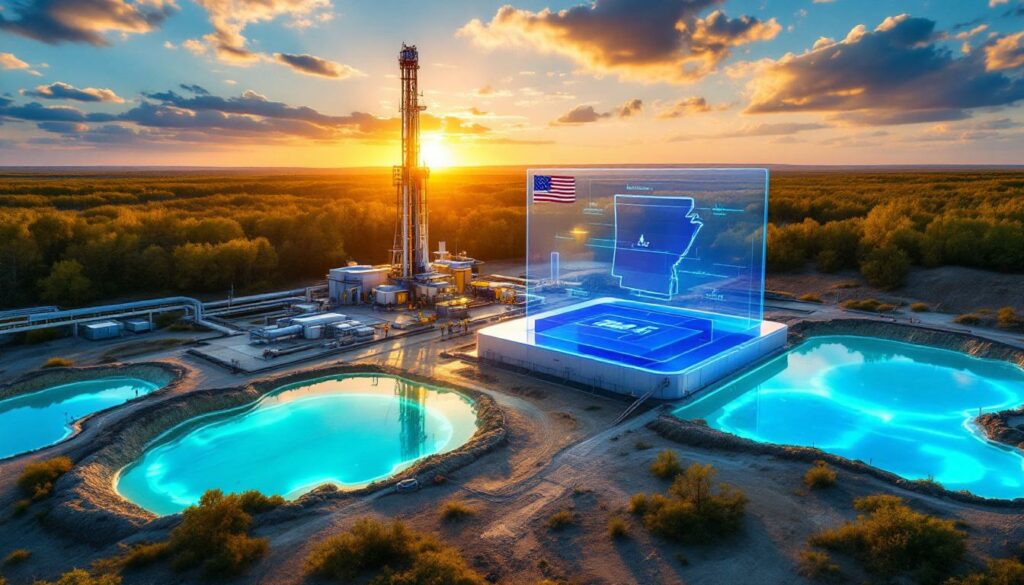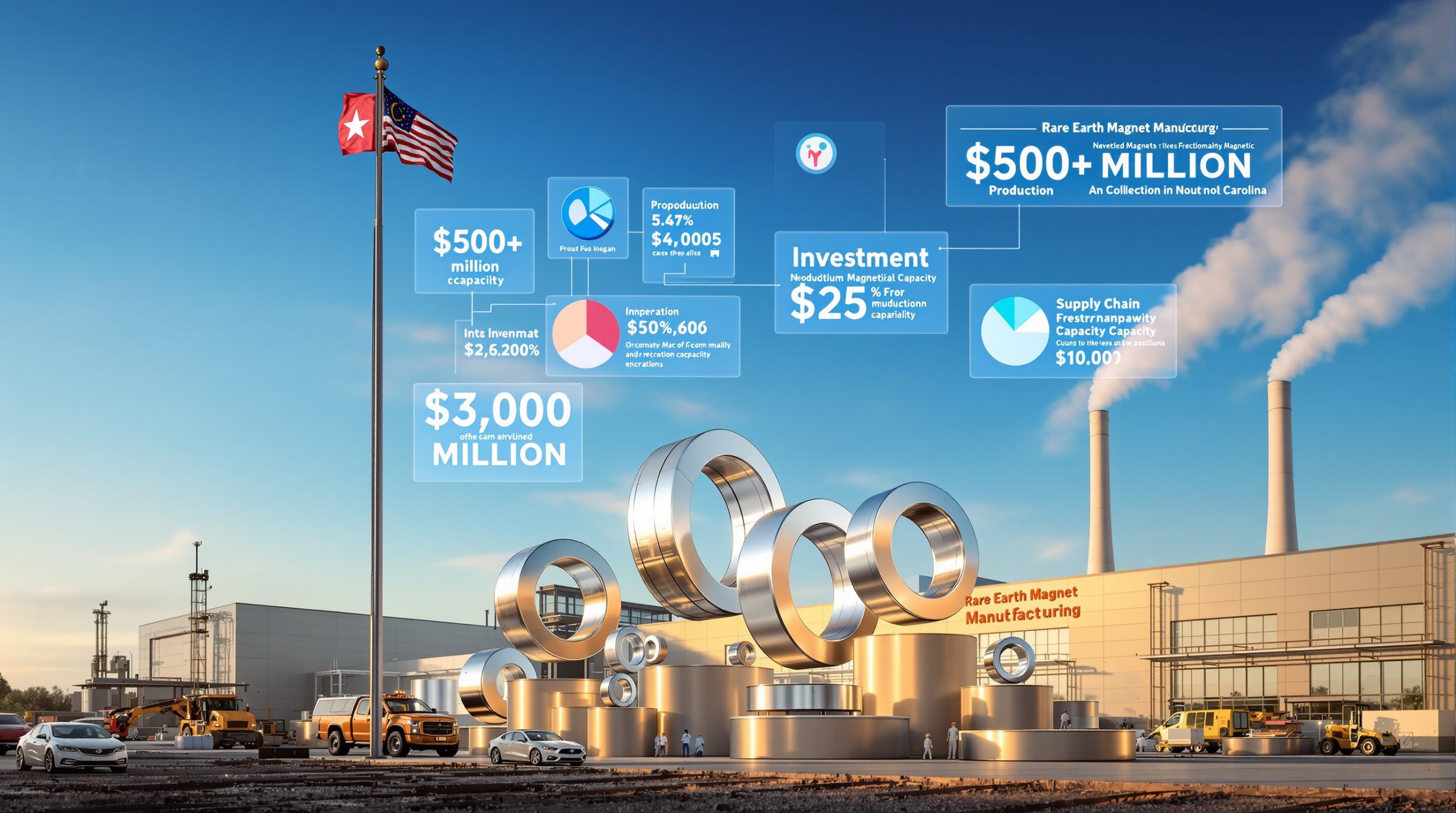Understanding the Smackover Formation Lithium Potential
The Smackover Formation stretches across parts of Arkansas, Texas, and Louisiana, representing one of North America's most promising lithium brine resources. This Jurassic-era geological formation, initially known for its oil and gas deposits, has gained significant attention for containing lithium-rich brines that can be accessed using advanced extraction technologies.
Formed approximately 150 million years ago from an ancient shallow sea, the Smackover Formation consists of limestone and dolomite layers saturated with mineral-rich brines. These naturally occurring brines contain lithium concentrations that make commercial extraction economically viable, particularly as lithium demand continues to surge for electric vehicle batteries and energy storage systems.
What Makes the Smackover Formation Unique?
The Smackover Formation offers several distinctive advantages compared to other lithium resources. Unlike the hard-rock lithium mines of Australia or the vast evaporation ponds of South America's "Lithium Triangle," Smackover's lithium exists in subsurface brines that can be accessed through wells, similar to oil and gas extraction.
This geological configuration allows for the application of Direct Lithium Extraction (DLE) technologies—advanced methods that can selectively extract lithium from brines without requiring large evaporation ponds or extensive processing. The formation's porosity and permeability characteristics make it particularly suitable for these innovative extraction approaches.
Strategic Importance to US Battery Supply Chain
The Smackover Formation represents a crucial component in America's strategy to reduce dependence on imported lithium. As of mid-2025, the United States imports more than 95% of its lithium, creating potential supply vulnerabilities for its growing electric vehicle and energy storage industries.
The region offers several strategic advantages for domestic lithium production:
- Existing infrastructure: Decades of oil and gas operations have established roads, utilities, and drilling capabilities that can be leveraged for lithium production
- Favorable regulatory environment: Arkansas has implemented specific frameworks to facilitate lithium development
- Proximity to manufacturing: The central U.S. location provides logistical advantages for supplying battery gigafactories being developed across the country
- Reduced geopolitical risk: Domestic production mitigates supply chain vulnerabilities associated with international sources
According to industry experts, the Smackover Formation could potentially supply a significant percentage of U.S. lithium needs if multiple projects reach commercial scale. This would represent a major shift in the domestic battery-grade lithium refinery supply chain landscape.
Who Are the Key Players Developing Smackover Lithium Projects?
The race to develop Smackover's lithium resources has attracted major energy companies and specialized lithium developers, each bringing unique expertise to these projects. The entrance of oil and gas majors into this space signals the formation's potential significance in the critical minerals energy transition.
Standard Lithium-Equinor Joint Venture
One of the most advanced Smackover lithium initiatives is the joint venture between Standard Lithium, a lithium development company, and Equinor, the Norwegian energy major. Their partnership combines Standard Lithium's DLE technology expertise with Equinor's subsurface knowledge and project development capabilities.
The joint venture is targeting commercial production by mid-2028, with a final investment decision expected by the end of 2025. Their development approach involves a phased scaling strategy, starting with demonstration facilities before expanding to commercial-scale operations.
Lisa Rebora, Equinor's Global Head of Lithium, emphasized the complementary nature of their partnership at the 2025 Fastmarkets Lithium Conference:
"Standard Lithium is a strong technology partner; Equinor brings subsurface expertise. This combination allows us to optimize flow sheets and technology to reduce costs."
David Park, Standard Lithium's CEO, reinforced their long-term perspective at the same conference:
"We're focused on long-term lithium demand beyond 2028. While controlling what we can: derisking projects and securing offtake agreements."
The joint venture has already received regulatory approvals, including the critical 2.5% royalty rate structure approved in May 2025, positioning them for advanced engineering studies and investment decisions.
Saltwerx (ExxonMobil Subsidiary)
ExxonMobil entered the Smackover lithium race through its subsidiary Saltwerx, leveraging its extensive oil and gas experience in the region. In June 2025, Saltwerx received approval from the Arkansas Oil and Gas Commission for a 2.5% royalty rate—matching the rate previously approved for the Standard Lithium-Equinor joint venture.
Patrick Horwath, ExxonMobil's Lithium Global Business Director, described this regulatory milestone as pivotal:
"The royalty approval was the last main regulatory step… Now it's time for us to deliver our projects."
Exxon's approach leverages its deep understanding of subsurface geology and fluid movement, which has already yielded operational efficiencies in preliminary development work. For instance, the company has reduced drilling time to target depths by applying techniques refined through decades of oil and gas operations.
Horwath further emphasized how oil and gas expertise transfers to lithium extraction:
"Understanding brine movement through columns unlocks capacity – a skill transferred from oil/gas."
Saltwerx is now advancing its engineering studies and preparing for project development decisions, though it has not yet publicly announced a specific production timeline.
Other Emerging Players in the Region
The Smackover's potential has attracted additional energy majors. Notably, Chevron recently acquired two leases in the region, validating the formation's prospects. While Chevron has not yet detailed its development plans, the company's entrance represents further institutional validation of the Smackover's commercial viability.
Several smaller specialized lithium developers are also exploring opportunities in the formation, potentially creating a diverse ecosystem of producers with varying scales and approaches. This competitive landscape could accelerate innovation while ensuring the region's resources are developed efficiently.
How Does Direct Lithium Extraction Technology Work in Smackover?
The development of Smackover lithium projects relies on Direct Lithium Extraction (DLE) technologies—advanced methods that represent a significant departure from traditional lithium production techniques. Understanding these technologies is crucial to appreciating why the Smackover Formation has attracted such substantial investment.
DLE Technology Advantages for Brine Resources
Unlike conventional lithium production that relies on solar evaporation ponds (which can take 18-24 months to concentrate lithium), DLE technologies can extract lithium directly from brines in hours or days. The process typically follows these steps:
- Brine is pumped to the surface through wells similar to those used in oil and gas production
- The brine undergoes pretreatment to remove impurities that might interfere with lithium extraction
- Lithium is selectively extracted via specialized adsorption or ion-exchange materials that preferentially bind to lithium ions
- The lithium is recovered from these materials through a stripping process
- The depleted brine is reinjected into the formation, minimizing water consumption and environmental impact
This approach offers several significant advantages:
- Reduced environmental footprint: Eliminates the need for large evaporation ponds that can span thousands of acres
- Higher recovery rates: Achieves over 90% lithium recovery versus 40-60% in traditional evaporation methods
- Faster production timeline: Reduces processing time from years to days
- Water conservation: Enables the return of processed brine to the formation
- Smaller surface footprint: Requires significantly less land area than evaporation pond operations
These benefits address many of the sustainability concerns associated with traditional lithium production while potentially improving economic outcomes through faster time-to-market and higher recovery rates.
Adapting Oil & Gas Expertise to Lithium Extraction
Companies developing Smackover lithium resources are leveraging significant crossover between oil and gas operations and DLE implementation. The skills and knowledge transfer creates unique advantages for these projects.
Key transferable capabilities include:
- Subsurface characterization: Understanding formation properties to optimize well placement
- Drilling efficiency: Applying proven techniques to reduce costs and improve accuracy
- Flow management: Optimizing brine movement through extraction systems
- Risk assessment: Utilizing established protocols from hydrocarbon production
- Project management: Applying large-scale energy project expertise to lithium development
Lisa Rebora of Equinor highlighted this knowledge transfer during industry panel discussions, noting how their subsurface modeling expertise helps optimize brine extraction and reinjection strategies. Similarly, ExxonMobil's Patrick Horwath emphasized how understanding fluid dynamics in porous media—a core oil and gas competency—directly applies to DLE operations.
This convergence of traditional energy expertise with innovative extraction technologies positions Smackover projects to potentially achieve operational efficiencies not available to greenfield lithium developments elsewhere.
What Recent Regulatory Developments Impact Smackover Lithium Projects?
The regulatory landscape for Smackover lithium projects has evolved significantly in recent years, with several key developments creating a more supportive environment for project advancement. These regulatory milestones have been critical in de-risking investments and establishing clear operational frameworks.
Royalty Rate Approvals and Their Significance
One of the most significant regulatory developments came in June 2025, when the Arkansas Oil and Gas Commission approved a 2.5% royalty rate for Saltwerx (ExxonMobil's subsidiary). This followed a similar approval for the Standard Lithium-Equinor joint venture in May 2025, establishing consistency across major projects in the region.
The royalty structure is based on the total value of lithium production, calculated using the quarterly average of Fastmarkets' assessment of lithium carbonate prices. As of June 27, 2025, this benchmark stood at $11.25-12.50 per kg, with the Q2 2025 average price at $11.73 per kg (down from $11.93 per kg in Q1 2025).
Patrick Horwath of ExxonMobil described the royalty approval as "the last main regulatory step" needed before projects can advance to final engineering studies and investment decisions. This standardized approach provides clarity for developers and helps establish the economic parameters for project evaluation.
The royalty framework represents a balance between generating state revenue and maintaining project competitiveness in global markets. By tying rates to market prices rather than imposing fixed fees, the structure accommodates market fluctuations while ensuring the state benefits from higher prices during market upswings.
Arkansas State Support for Lithium Development
Beyond specific royalty approvals, the Arkansas state government has implemented a comprehensive strategy to support lithium sector development. These initiatives aim to create an ecosystem that extends beyond extraction to include downstream processing and manufacturing.
Key elements of Arkansas' lithium development strategy include:
- Economic incentives: Tax benefits specifically designed for lithium production and processing
- Workforce development: Programs to train local workers in collaboration with community colleges
- Innovation support: Creation of an "accelerator" program to foster lithium-sector entrepreneurship
- Industry collaboration: Hosting the Arkansas Lithium Innovation Summit (scheduled for October 28-29, 2025)
- Infrastructure investment: Strategic improvements to support industry growth
Hugh McDonald, Arkansas Commerce Secretary, emphasized this comprehensive approach at industry conferences:
"We're working to attract battery manufacturers to Arkansas… leveraging lithium produced in-state."
This state-level support complements federal initiatives under the Inflation Reduction Act, which provides incentives for domestic critical mineral production and battery manufacturing. Together, these policies create a supportive environment for Smackover lithium development that extends from extraction through the value chain.
How Are Market Conditions Affecting Smackover Development Plans?
Despite the strategic importance of developing domestic lithium resources, Smackover projects must navigate market realities that influence investment decisions and development timelines. Understanding current market conditions and long-term fundamentals provides crucial context for evaluating project viability.
Navigating the Current Lithium Price Environment
The lithium market has experienced significant volatility in recent years. After reaching historic highs in 2022-2023, prices have undergone a substantial correction. As of June 2025, Fastmarkets assessed lithium carbonate prices at $11.25-12.50 per kg—well below previous peaks but still above historical averages.
Recent price trends show continued softening, with the Q2 2025 average price of $11.73 per kg representing a 1.7% decline from the Q1 2025 average of $11.93 per kg. This downward pressure reflects increased supply coming online globally, temporarily outpacing demand growth.
Companies developing Smackover resources are responding to these market conditions by:
- Optimizing project economics to ensure viability at lower price points
- Phasing development to manage capital expenditure timing
- Securing strategic partnerships and offtake agreements
- Focusing on operational efficiency and cost reduction
- Emphasizing the premium value of domestic production
David Park, Standard Lithium's CEO, articulated this approach at industry conferences, emphasizing their focus on "controlling what we can: derisking projects and securing offtake agreements" rather than reacting to short-term price movements.
Long-Term Market Outlook Beyond Current Downturn
Despite current market softness, companies developing Smackover lithium resources maintain a decidedly long-term perspective. Their investment decisions reflect confidence in lithium demand growth driven by electric vehicle adoption and energy storage deployment.
Patrick Horwath of ExxonMobil captured this multi-decade view:
"We take a multi-decade view; the world needs more lithium than produced today."
This long-term outlook is supported by several fundamental factors:
- Electric vehicle growth projections: Major automakers have committed hundreds of billions to electrification
- Battery manufacturing expansion: Gigafactory announcements continue despite market volatility
- Energy storage deployment: Grid-scale battery installations are accelerating globally
- Policy support: Governments worldwide are implementing measures to accelerate the energy transition
Companies are positioning Smackover projects to come online around 2028—a timeline that aligns with projected supply gaps as EV adoption accelerates. This strategic timing could allow projects to avoid current market oversupply while preparing for the next demand surge.
The current market environment may ultimately strengthen Smackover projects by enforcing cost discipline and operational efficiency during the development phase. Projects that advance through this challenging period may emerge more resilient and competitive in the long run.
What Challenges Must Smackover Lithium Projects Overcome?
Despite their promising potential, Smackover lithium projects face several significant challenges that must be addressed to achieve commercial success. These hurdles range from technical and operational issues to broader supply chain and infrastructure constraints.
Technical and Operational Hurdles
Developing commercial-scale DLE operations in the Smackover Formation involves overcoming several technical challenges:
- Technology optimization: DLE technologies must be fine-tuned for the specific chemical composition of Smackover brines, which contain various impurities and competing ions that can affect extraction efficiency.
- Scale-up risks: Moving from pilot operations to commercial-scale production introduces complexities in maintaining consistent performance and recovery rates.
- Operational integration: Combining extraction, processing, and reinjection systems requires careful engineering to ensure reliable operation.
- Quality control: Producing battery-grade lithium compounds requires consistent purity levels that meet stringent specifications.
- Water management: Optimizing water use and ensuring proper handling of process fluids presents ongoing operational challenges.
Project developers are addressing these challenges through extensive pilot testing, engineering studies, and collaboration with technology providers. The involvement of major energy companies brings valuable experience in managing complex extraction operations, potentially mitigating some of these technical risks.
Supply Chain and Infrastructure Development Needs
Perhaps the most significant challenge facing Smackover lithium projects is the lack of midstream processing infrastructure in the United States. Patrick Horwath of ExxonMobil highlighted this critical gap:
"The US lacks midstream cathode capacity – a critical gap for supply chains."
This infrastructure deficit includes:
- Limited refining capacity: Insufficient facilities to convert lithium chloride or hydroxide to battery-grade materials
- Underdeveloped cathode production: Few domestic manufacturers of lithium-ion battery cathodes
- Logistics constraints: Underdeveloped transportation networks for lithium chemicals
- Workforce gaps: Shortage of skilled workers with relevant experience in lithium processing
Addressing these gaps requires coordination between project developers, downstream manufacturers, and government agencies. Hugh McDonald, Arkansas Commerce Secretary, emphasized state efforts to address these challenges through an "accelerator" program designed to foster lithium-sector entrepreneurship and attract complementary businesses.
Industry leaders note that establishing complete supply chains—from extraction through battery manufacturing—represents both a challenge and opportunity. Projects that can integrate vertically or establish strategic partnerships across the value chain may gain competitive advantages while addressing infrastructure gaps.
How Does Smackover Compare to Global Lithium Sources?
As Smackover lithium projects advance toward production, they must compete in a global marketplace with established producers and other emerging resources. Understanding this competitive landscape is essential for assessing the long-term viability and strategic importance of these projects.
Competitive Position Analysis
Smackover lithium projects face competition from several established and emerging global sources:
- Australian hard rock mines: Currently the world's largest lithium source, with established supply chains and expansion potential thanks to Australian lithium tax breaks
- Chilean and Argentine salars: Traditional brine operations with decades of production experience and evolving lithium brine market insights
- Chinese domestic resources: Significant production
Ready to Stay Ahead in the Lithium Market?
Discover real-time alerts on significant ASX mining announcements, including emerging lithium opportunities, with Discovery Alert's proprietary Discovery IQ model, giving you the edge before market movements. Explore historic discovery returns and their potential impact on your portfolio by visiting our dedicated discoveries page.




